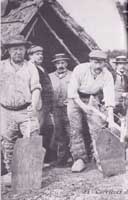
Ardoisiers with traditional tools and wooden shoes (sabots)
Ardoisiers
 |
Ardoisiers with traditional tools and wooden shoes (sabots) |
Ardoisiers, or slate workers, play a significant role in Anjou, where the blue-gray slates of the Massif Armorican in northwestern France have been quarried for centuries. When Joachim du Bellay longs for the douceur angevine of his native land, he also praises the slate building material over hard marble:
Plus que le marbre dur me plait l'ardoise fine...

|
Escalier de la Maison de l'ardoise |
St Lézin (or Licinius), a sixth-century bishop of Angers, is accredited with the invention of slate roofs. Thus, he becomes the patron saint of the Ardoisiers, who celebrate his feast on February 13th. Slate usage can be dated to the twelfth century, with roofs preserved from at least as early as the fourteenth century. Principal mines were located at Trélazé, Noyant la Gravoyère, and Combrée, La Pouèze.
Demand for slate was quite high in the 18th century onwards, and Ardoisiers labored to produce under brutal conditions. In the 19th century, the industry was organized. In 1808, the sellers formed a Société commerciale which led in 1827 to the creation of "la Commission Centrale des Ardoisières d'Angers", and in 1891 to "la Commission des Ardoisières d'Angers".
In the 19th century, the Ardoisiers were known as fervent supporters of the Revolutionary politics. Their first labor union (syndicat ardoisier) was created in 1848, and their members responded loudly to the politics of the day. As members of the secret society "La Marianne," they marched on Angers in 26-27 August 1855. Napoleon III ordered them arrested and sentenced to hard labor, but they were not so easily restrained. 1864 marked the formation of la Société Ardoisière de Grand-Maison and pro-union legislation gave them the right to strike, among other things. From 1894 until 1986 the workers came together in "la société des Ardoisières de l'Anjou." At the turn of the century, many ardoisiers entertained anarchist sympathies. They are prominent in pro-labor politics well into the 20th century, achieving many victories for workers' protections in the Mining laws of 1947.
Today, the Ardoisiers are trying to preserve the elements of their noble history. The traditional methods of quarrying have long disappeared through mechanization, and many of the old slate deposits are no longer being mined. Museums in Trélazé and Renazé try to preserve the old ways for the education of contemporaries.

|
Le quernon d'Ardoise is a specialty of Angers. This chocolate-covered nut-filled nougat is formed in imitation of a slate roof tile. |
This page was meant to be viewed in frames. |
 Return to Return toAmelia Carr's Home Page |